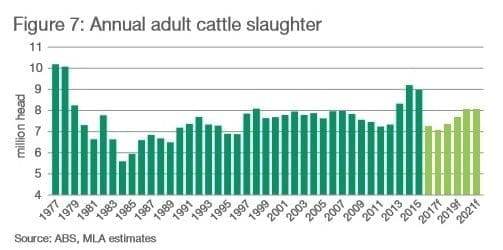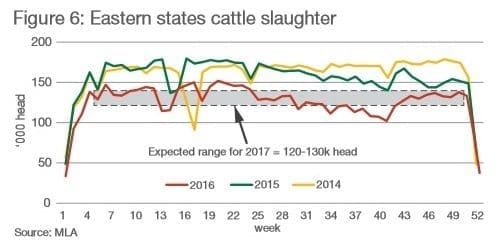EASTERN States beef kills are expanding following the Christmas break, but progress is restrained, to say the least.
The National Livestock Reporting Service logged a seven-day eastern states kill last week of just short of 113,000 head. The same week last year, when seasonal conditions and meat market circumstances in many areas were not dissimilar to today, was 18 percent higher, representing an additional 20,300 head for the week.
It perhaps captures the conservative mood again being applied by meat processors, with the continued lack of alignment between flat export meat prices and what the market can afford to pay for slaughter cattle in what is a very limited pool of slaughter cattle.
Meat & Livestock Australia’s 2017 Industry Projections released yesterday suggests this year’s beef kill will decline a further three percent (following a 19pc reduction last year), to around 7.1 million head. Contrast this with the 2014 and 2015 ‘boom’ years, when slaughter numbers exceeded nine million head each year.
The primary reason for the lower slaughter this year is the expectation that many producers will be retaining as many cattle as possible to replenish depleted herds, and, even though the herd is now larger than a year ago, it is still historically low. Depletion of young cattle numbers, through cow liquidation and poorer reproductive performance in breeders during the drought years, is also being reflected in current supply problems.
MLA says the majority of the 200,000 head decline in kill forecast this year is likely to be made up of females, based on the expectation of strong herd rebuilding momentum. That could flow on to lower lean manufacturing beef volumes relative to prime cuts.

For the eastern states covered in NLRS’s weekly kill report, MLA’s expectation for the duration of 2017 is for weekly kill to range from 120,000 to 130,000 head, with the first half of the year hovering closer to the lower end of that range, before moving towards the upper end in the second half.
This will be dramatically lower than periods during 2015-16, when weekly kills frequently exceeded 180,000 head.
From 2018, rate of slaughter is likely to gradually return to long-term average levels, MLA suggests. Looking further ahead, cattle slaughter should continue to gradually increase, before eventually reaching 8 million head again by 2021. That’s still around 1 million head below the 2014 and 2015 peaks during the herd liquidation.

Grids remain steady
Southern Queensland processor grids this week remain unchanged, showing offers from 530c-540c/kg for the industry benchmark four-tooth heavy grassfed ox, and heavy cows at 480-485c/kg. A northern NSW export plant has offers for the current week at 525c/kg for four-tooth grassfed steer (5c less for HGP), and 470c for full-mouth heavy cow.
Queensland’s kill last week fell just short of 50,000 head, up 31pcv on the week before, but still 15pc below year-ago levels.
New South Wales processed 31,500 for the week, back 11pc year-on-year, while Victoria slaughtered 20,337, down 34oc in yearly comparisons. South Australia’s kill just topped 7000 head, down 6pc, while Tasman accounted for 4254 head, down 15pc.
